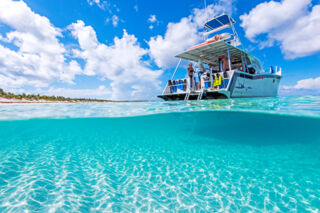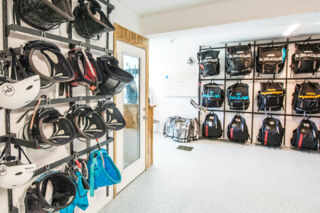Turks and Caicos Kiteboarding Guide
Kiteboarding Guides By Island




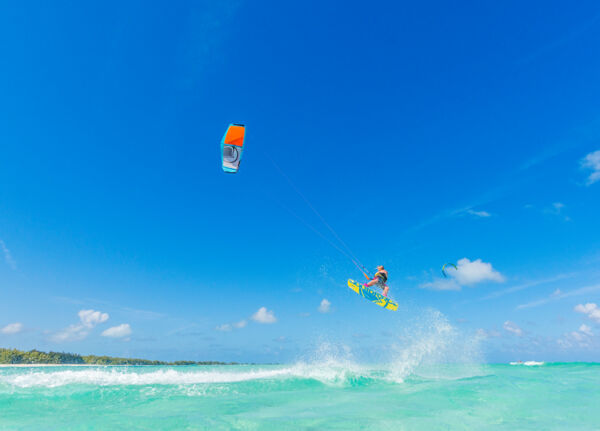
The Turks and Caicos is one of the finest kiteboarding destinations in the tropical Atlantic and Caribbean. This isn’t a surprise, considering the territory's exquisite clear and shallow water and the forgiving sandy ocean floor of the country’s top kite spots.
Much of the country’s kiting culture is based on the island of Providenciales. Here, you will find all of the kite schools, most of the local kiteboarders, and the country's best kiteboarding location (Long Bay Beach). Most areas of this bay are only waist-deep, making it perfect for beginners and equally enjoyable for advanced riders. Using a foil is typically only possible at high tide, as the water is too shallow at low tide. There are a variety of rental villas on this beach along with the H2O Life. Style. Resort., a water sports resort and kite school.
As with most beaches on the leeward side of the island of Providenciales, Grace Bay Beach is not a popular location for kiteboarding due to the wind direction, however kiters are occasionally seen in this area. Chalk Sound is also not a good location for kiteboarding, as the hills, islands, and houses in the area create gusty wind.
Weather and Wind
Statistically, the winter season is the most consistent in terms of wind, yet there’s not a huge difference throughout the year.
The most predictable and consistent wind in the Turks and Caicos is the east-southeast trade winds. The islands typically experience this wind on and off throughout the year, although wind conditions are usually a bit more pronounced and regular in the spring and winter months.
Squalls, regional storms, tropical cyclones, and some instances of rougher weather occasionally cause different wind directions, which make north and west coast locations more viable. However, these winds are uncommon and unpredictable for vacation planning.
Lessons and Equipment
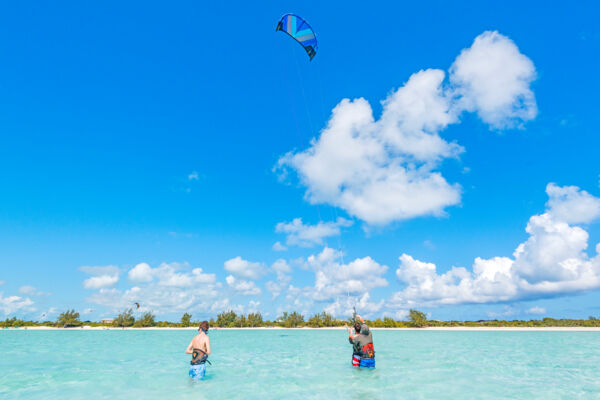
Currently, all kiteboarding instructors and kite schools are based on Providenciales. Lessons can often be arranged on the other islands in the country at extra cost, yet it’s easiest to learn on Providenciales.
It varies greatly by student, but it typically takes between 5 and 8 hours of lessons before students can begin to practice kiteboarding by themselves, after which it usually takes another 8–10 hours before the student is able to kite upwind (and back to the launch point). Kiteboarding is considered to be a mid- to higher-level difficulty sport to learn in relation to other water sports. The learning curve isn't as steep as it is for conventional surfing, yet it does take more commitment than paddleboarding and kayaking.
New designs and kite technologies have made the sport much easier to learn, and kiteboarding lessons and teaching methods have also improved greatly over the years. Most kite schools teach at Long Bay Beach, which is one of the best kiteboarding locations in the world and an incredible place to practice.
Kiteboarding Schools
The main kiteboarding schools offer complete lesson packages that are designed to advance you to the skill level of being able to kite on your own. If you’ve made the decision to start kitesurfing, this is the recommended route to go. Lessons cost around $150–200 per hour, or $500–1,000 for a beginner package. There are deals that include accommodation as well.
Lessons also include jet ski support during instruction to ensure rider safety.
The Providenciales kite schools can also rent all necessary equipment to intermediate or advanced kiters, but require proof of competency before doing so. Kiteboarding rental outfitters will typically require that you provide them with an IKO Card (level 3K), or ask you to complete a skills demonstration. An equipment set rents for around $200 per day, and a complete setup with harness and board is approximately $800 per week.
How Do The Islands Compare for Kiting?
Providenciales is of course the center of kiteboarding in the Turks and Caicos, and along with lessons and equipment sales and repairs, all kite tours and downwinder safaris are operated from this island. However, nearly all of the islands offer great areas to kite and discover.
Providenciales, North Caicos, and Middle Caicos
In terms of actual kite locations, Providenciales, North Caicos, and Middle Caicos all offer a wonderful selection of great settings, and you’ll typically be able to find a rideable spot no matter the wind direction.
The southern sides of these islands are on the Caicos Banks: an extensive and shallow bank that features some of the world's most turquoise ocean water. This region is teeming with wildlife, and it's possible to see stingrays, turtles, barracudas, and small sharks gliding by. Verdant red mangroves line many of the southern coasts adjacent to the Caicos Banks, and are likewise quite scenic and fun to explore.
On the north coasts of these central Caicos Islands are spectacular sites with differing atmospheres. There’s Half Moon Bay Beach and a nearby shallow lagoon, the beaches at Fort George Cay, Pine Cay, and Water Cay, the rugged and majestic Mudjin Harbour, and the remote and spectacular Cedar Point and Wild Cow Run. Experienced kiters will have endless sites to explore.
South Caicos
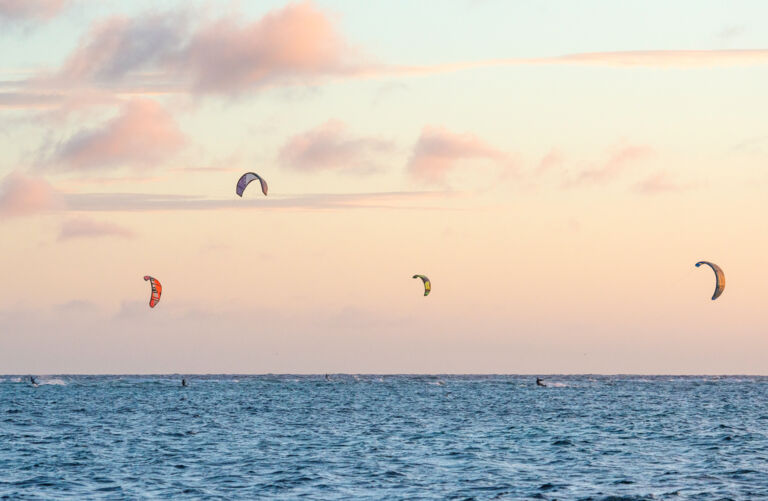
South Caicos isn’t particularly far from the central Caicos Islands and Providenciales, yet the uninhabited East Caicos and extensive shallows tend to isolate it a bit. Consequently, those wishing to kite the pristine flats here will typically have to stay overnight. See South Caicos Hotels and Resorts.
You can venture off the beaten track as much or as little as you’d like on South Caicos. The beautiful Salterra Beach is a stellar location that’s easy to get to, Bell Sound offers flat water, and the channels and cays to the north of the island at Plandon Cay Cut, McCartney Cay, and Middle Creek Cay form one of the most scenic regions in the Turks and Caicos.
Long Cay and the amazing waters of the Admiral Cockburn Land and Sea National Park is also a great spot and close to the island’s main settlement of Cockburn Harbour.
Grand Turk and Salt Cay
Grand Turk and Salt Cay unfortunately don’t offer the spectacular kite spots that the Caicos Islands do, yet good locations can be found.
Both islands are small, have limited sheltered coves and wetlands, and the east and southeast coasts of these islands tend to be a little rough when the wind is up. The west coast beaches on Grand Turk and Salt Cay are nice and have relatively tame water, but the wind is almost always offshore.
A positive of these two islands is that wind tends to be consistent, a bit more constant, and better follows the predictions.
Traveling With Kite Gear
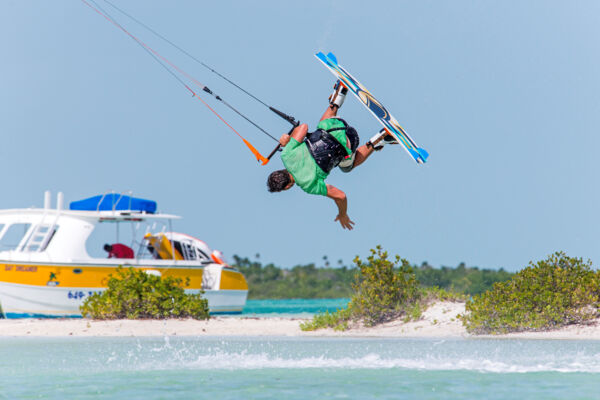
A common concern to international kiters is the cost, difficulty, and risk of equipment damage when traveling. International airlines all have varying policies, and enforcement may be random, yet expect to pay additional fees.
Many airlines allow golf club bags to fall under the typical bag rate regardless of whether they exceed maximum length dimensions, and this has led to comical and giant kite luggage that’s styled to look like a golf bag, complete with unmissable “golf bag” lettering. In any case, kiteboarders have it better than windsurfers and long board surfers when it comes to traveling.
Waves and swells are unpredictable and a little too uncommon, and the best kite locations tend to be shallow, so it may be best to leave the fragile surf boards and foils at home.
Domestic Flights and Ferries

Travel between the islands typically takes place on small passenger ferry boats and small twin turboprop aircraft that seat between 10 and 20 passengers.
Generally, there are no restrictions or lack of luggage space on the ferries. There may technically be excess baggage fees above certain amounts, yet these fees are seldom enforced.
The local airlines generally try to be accommodating, yet there’s only so much space on a tiny airplane. There’s a decent chance that excess and oversize baggage fees will be applied, and if the flight is at full capacity, items may be delayed to another flight.
Downwind Kite Safaris
A great activity for a capable kiter is a downwind kite safari through the spectacular and uninhabited cays.
These adventures begin by loading a boat with all of the kite gear and refreshments and traveling to a great launch point, often on an uninhabited island. Kiters set up and take off, the pumps and bags are reloaded, and the support boat follows the group downwind.
A kite safari is simply a lot of fun. You’ll be able to race through the islands if you’d like, or you can take time exploring the coves and channels. Wildlife abounds, which simply adds to the experience.
Both private charters and shared excursions are available.
Bookings and Reservations
Given that kiteboarding is dependent on the wind, the Turks and Caicos kiteboarding schools are typically accommodating if the conditions aren't cooperating. In the event of very low or no wind, most instructors will reschedule you for the next available lesson (or refund your reservation in full if this isn't possible).
Different kite schools have different cancellation policies. During the peak kiting months of December, January, March, and April, some kiting schools enforce a zero cancellation policy. At other times, they may require a minimum of two days notice or as much as 30 days notice for free cancellation, with penalties and fees applied for shorter notice.
If you plan to visit the Turks and Caicos Islands during the peak kiteboarding months, be sure to reserve your kiteboarding lesson or kiteboarding safari well in advance to ensure availability.
Kite Schools and Rental Companies
